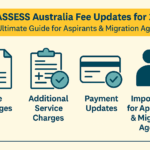The Adventure of a Lifetime: A Realistic Look at Studying Abroad
Here at Sherin Overseas Education, we believe that choosing to study in a foreign country is one of the most powerful decisions a student can
OSCA’s quiet arrival: Rethinking how Australia defines work
Australia’s new job classification system, OSCA, replaces ANZSCO with little fanfare. Its streamlined approach raises questions about workforce planning, transparency, and the evolving definition of
GREAT Scholarships for justice and law
GREAT Scholarships for justice and law are for students who want to study law at a UK university for a one-year postgraduate course. Students can
GREAT Scholarships for science and technology
GREAT Scholarships for science and technology are for students who want to study related subjects at a UK university for a one-year postgraduate course. Students
Apply for a GREAT Scholarship, hear student stories and manage your wellbeing
GREAT Scholarships offer students from 18 countries the opportunity to have £10,000 towards their tuition fees for a wide range of one-year taught postgraduate courses.
Streamlined study requirement for Temporary Graduate visas
Temporary Graduate visa (TGV) streams and study requirements The study requirement for a Temporary Graduate visa (TGV) has changed for Graduate Certificate and Graduate Diploma
Skills in Demand (subclass 482) visa
Australia’s 2023 Migration Strategy provides clearer post-study pathways for Australia’s international students. These include opportunities to stay and work in Australia if your skills and qualifications are
Announcement of Pathway 1 Closure for this Program Year
Announcement of Pathway 1 Closure 491 Pathway 1 is now closed for new applications for this program year We are writing to advise that we
Australia immigration: Oppn eyes investor ban, 25% permanent migration cut
Australia’s upcoming May 2025 federal election could bring major changes for Indian migrants, with the opposition Coalition proposing strict migration and education reforms. If elected,
Ten New Roles Added To ACS Skilled Migration Assessing Authority
ACS, the professional association for Australia’s technology sector, has announced ten new specialist occupations are now available under its Migration Skills Assessment program. Australian












